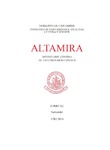La transformación del paisaje del fondo de la bahía de Santander: el agua, la rueda, el hierro y la velocidad

Use este enlace para citar
http://hdl.handle.net/2183/38256Colecciones
- Investigación (ETSECCP) [826]
Metadatos
Mostrar el registro completo del ítemTítulo
La transformación del paisaje del fondo de la bahía de Santander: el agua, la rueda, el hierro y la velocidadAutor(es)
Fecha
2019Cita bibliográfica
Nárdiz, C. (2019). La transformación del paisaje del fondo de la bahía de Santander: el agua, la rueda, el hierro y la velocidad. Altamira: Revista del Centro de Estudios Montañeses, 90, 255-300.
Resumen
[Resumen:] La conferencia analiza cuatro momentos en la transformación del paisaje del fondo de la bahía de Santander, que tienen que ver con los cambios experimentados por las rías de Boo, Astillero, Solía y San Salvador. El agua se relaciona con las características privilegiadas de la bahía, que dio lugar ya en el siglo XVII a la localización en ella del Real Astillero de Guarnizo y la promoción de la villa en relación a los baños de mar, que entrarán en conflicto a partir del siglo XIX con la localización de la industria y la minería. La rueda se relaciona con la transformación de la red viaria, a partir del primer camino de ruedas entre Santander y el puente de Solía en el siglo XVI, y la construcción de las carreteras modernas en el siglo XIX y comienzos del XX. El hierro se relaciona con la construcción de las líneas del ferrocarril que atravesaron el fondo de la bahía y con la minería en torno a la Sierra de Cabarga, que originó, a su vez, la implantación de nuevos ferrocarriles desde los lavaderos hasta los embarcaderos en las rías, con concesiones de marismas para los fangos. La velocidad se relaciona con la construcción de las nuevas carreteras a partir de mediados del siglo XX, para unir Santander con el puente de San Salvador, con la integración creciente de las villas de Maliaño y Astillero en el área urbana de Santander. El salto de escala se producirá con las autovías, que atravesarán las rías sin concesiones al paisaje del fondo de la bahía. El contrapunto serán los recorridos peatonales y en bicicleta, que se potenciarán a partir de finales del siglo XX con el apoyo a las vías verdes del ferrocarril, con una red de itinerarios, conectando parques, que en el futuro se extiendan al área metropolitana de Santander. [Abstract:] The conference is related to four moments in the transformation of the landscape of the bottom of the Bay of Santander, which have to do with the transformations of the estuaries of Boo, Astillero, Solía and San Salvador. The water is related to the privileged characteristics of the bay, which gave rise in the 17th century to the location of the Royal Shipyard of Guarnizo, and the promotion of the town in relation to the sea baths, which will enter into conflict starting from XIX century with the location of industry and mining. The wheel is related to the transformation of the road network, from the first road of wheels between Santander and the bridge of Solía in the sixteenth century, and the construction of modern roads in the nineteenth and early twentieth centuries. The iron is related to the construction of the railroad lines that crossed the bottom of the bay, and to mining around the Sierra de Cabarga, which built new railways from the laundries to the jetties in the estuaries. marsh concessions for mud. The speed is related to the construction of new roads from the mid-twentieth century, to join Santander with the bridge of San Salvador, with the growing integration of the towns of Maliaño and Astillero in the urban area of Santander. The jump of scale will take place with the freeways, that will cross the estuaries without concessions to the landscape of the bottom of the bay. The counterpoint will be the pedestrian and bicycle routes, which will be strengthened from the end of the 20th century, with the support of the greenways of the railway, in a network of routes, connecting parks, which in future will extend to the metropolitan area of Santander.
Palabras clave
Paisaje
Astillero
Agua
Rueda
Hierro
Velocidad
Landscape
Shipyard
Water
Wheel
Iron
Speed
Astillero
Agua
Rueda
Hierro
Velocidad
Landscape
Shipyard
Water
Wheel
Iron
Speed
ISSN
0211-4003





